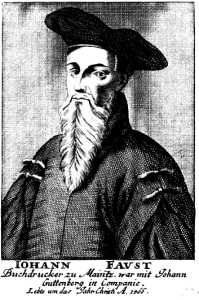[Witchcraft accusations. Johann Fust (c. 1400 – October 30, 1466) was a business partner of Gutenberg, who invented movable type printing, which enabled mass production of books instead of hand-written manuscripts. Fust is sometimes confused with Faust, and has even been nominated as possibly the original Faust by some. Fust took some of Gutenberg’s newly printed bibles and tried to sell them in Paris:]

“It was once believed that Johann Fust was working for the devil. After several of Gutenberg’s bibles were sold to King Louis XI of France, it was decided that Fust was performing witchcraft. This idea came about for a few reasons, including the fact that some of the type was printed in red ink, mistaken for blood. It was also discovered that all of the letters in these bibles, presented to the King and his courtiers as hand-copied manuscripts, were oddly identical. Fust had sold 50 bibles in Paris and the people there could not fathom the making and selling of so many bibles so quickly, because printing had not come to the forefront yet in France. Parisians figured that the devil had something to do with the making of these copies, and Fust was thrown into jail on charges of black magic. He was eventually released, since it was proved he was running a business in which printing enabled the rapid production of multiple copies of the same text.”

